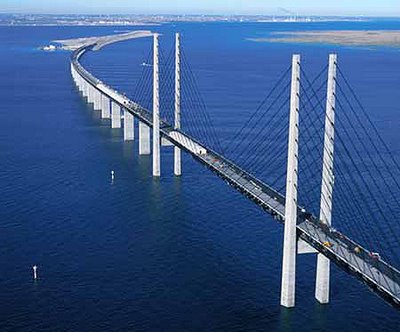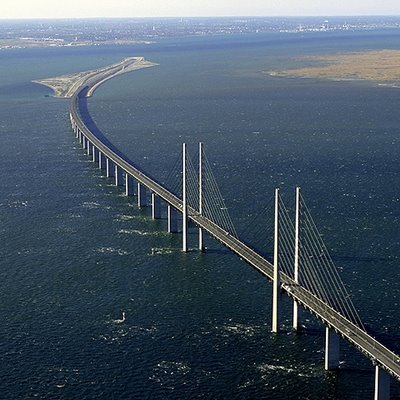 In 1991, the Danish and Swedish governments signed an agreement to establish a fixed link across the Øresund. The agreement was ratified by the two countries' parliaments in August of the same year. Øresundskonsortiet, a joint venture between A/S Øresund and Svensk-Danska Broförbindelsen SVEDAB AB, constructed the permanent link between Sweden and Denmark. The project cost more than DKK12 billion and comprises a 16.4km (10-mile) link between Copenhagen and Malmö consisting of a tunnel, a bridge and an artificial island.
In 1991, the Danish and Swedish governments signed an agreement to establish a fixed link across the Øresund. The agreement was ratified by the two countries' parliaments in August of the same year. Øresundskonsortiet, a joint venture between A/S Øresund and Svensk-Danska Broförbindelsen SVEDAB AB, constructed the permanent link between Sweden and Denmark. The project cost more than DKK12 billion and comprises a 16.4km (10-mile) link between Copenhagen and Malmö consisting of a tunnel, a bridge and an artificial island.In May 2003 the Øresund Bridge won the IABSE Outstanding Structure Award. The judges commended the project for its innovative planning, design and construction management as well as its compliance with the time schedule, budget and tough environmental requirements.
 The Øresund Bridge was inaugurated in July 2000. The bridge two-level superstructure is fabricated from steel and concrete. The steel girder supports the upper deck, which accommodates the motorway, and the lower deck where the railway is located. The tracks are placed in a concrete trough along the approach bridges, which changes to a steel deck on the high bridge.
The Øresund Bridge was inaugurated in July 2000. The bridge two-level superstructure is fabricated from steel and concrete. The steel girder supports the upper deck, which accommodates the motorway, and the lower deck where the railway is located. The tracks are placed in a concrete trough along the approach bridges, which changes to a steel deck on the high bridge.ØRESUND TUNNEL
The western part of the Øresund Link is a 4km-long tunnel between the artificial island of Peberholm and the artificial peninsula at Kastrup. The tunnel is the longest immersed tube tunnel for both road and rail traffic in the world. It consists of 20 tunnel elements.
ARTIFICIAL ISLAND (PEBERHOLM) AND PENINSULA
The artificial island of Peberholm was built in order to transfer the traffic from the immersed tunnel up onto the approach bridge. Peberholm is approx. 4km long and mainly made up of dredged material from the Øresund seabed. A total of 1.6 million m³ of stone and 7.5 million m³ of sand and dredged material were required for its completion.

No comments:
Post a Comment